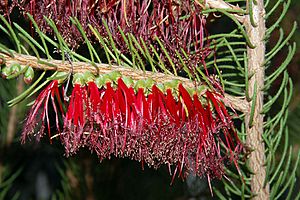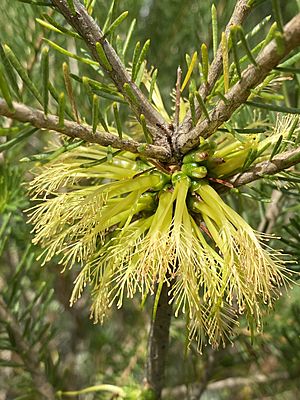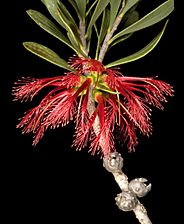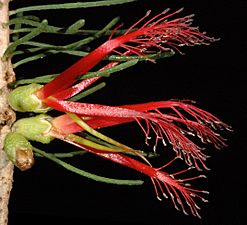One-sided bottlebrush facts for kids
Quick facts for kids One-sided bottlebrush |
|
|---|---|
 |
|
| Scientific classification | |
| Genus: |
Calothamnus
|
| Species: |
quadrifidus
|
| Synonyms | |
|
Melaleuca quadrifida (R.Br.) Craven & R.D.Edwards |
|
The Calothamnus quadrifidus, also known as the one-sided bottlebrush, is a special plant. It belongs to the myrtle family and grows only in the south-west part of Western Australia. Its common name, "one-sided bottlebrush," comes from how its flowers grow. They line up neatly on just one side of the stem, looking a bit like a bottle brush.
This plant is a shrub with soft, grey-green leaves that look a bit like pine needles. In spring, it shows off beautiful red flowers that have four parts. Many people like to grow it in their gardens because its leaves are pretty, and its flowers are colorful and unusual. It can grow in many different places and types of soil. Scientists have studied this plant a lot. In 2010, a botanist named Alex George looked closely at the species and found several new types, called subspecies.
Contents
What the Plant Looks Like
The one-sided bottlebrush is usually a shrub. It often grows to be much less than 5 metres (20 ft) (about 16 feet) tall. Its leaves can look different depending on the specific type of plant. They are usually 10–50 millimetres (0.4–2 in) (0.4 to 2 inches) long and 0.8–10 millimetres (0.03–0.4 in) (0.03 to 0.4 inches) wide. Some leaves are round, like a pencil, while others are flat.
The flowers are usually bright red, but you can also find some with white or yellow flowers. The red ones are the most common in gardens. These flowers grow in groups, usually on one side of the stem, hidden among the older leaves. Each flower has four small petals that are about 3.5–4 millimetres (0.1–0.2 in) (0.14 to 0.16 inches) long. These petals fall off soon after the flower opens. The stamens (the parts that make pollen) are grouped into four claw-like bundles. Most types of this plant flower in spring. After the flowers, the plant grows woody, barrel-shaped fruits called capsules, which are 6–14 millimetres (0.24–0.55 in) (0.24 to 0.55 inches) long.
Plant Names and Types
The one-sided bottlebrush was first officially described in 1812 by a scientist named Robert Brown. He found a sample of the plant at Lucky Bay in Western Australia during an exploration trip with Matthew Flinders.
Scientists have identified several different types, or "subspecies," of Calothamnus quadrifidus. These are recognized by the Western Australian Herbarium:
- Calothamnus quadrifidus subsp. angustifolius: This type has flat leaves that are longer than 40 millimetres (2 in) (1.6 inches) and narrower than 4 millimetres (0.2 in) (0.16 inches).
- Calothamnus quadrifidus subsp. asper: This type has flat leaves that are shorter than 30 millimetres (1 in) (1.2 inches) and feel rough or scaly.
- Calothamnus quadrifidus subsp. homalophyllus: This type has flat leaves that are longer than 40 millimetres (2 in) (1.6 inches) and wider than 4 millimetres (0.2 in) (0.16 inches).
- Calothamnus quadrifidus subsp. obtusus: This type has flat leaves that are a bit rough and scaly. Its stamen bundles are shorter than 21 millimetres (0.8 in) (0.83 inches).
- Calothamnus quadrifidus subsp. petraeus: This type has flat leaves that are somewhat rough and scaly. Its stamen bundles are longer than 24 millimetres (0.9 in) (0.94 inches), and its fruits are 10–11 millimetres (0.39–0.43 in) (0.39 to 0.43 inches) long.
- Calothamnus quadrifidus subsp. quadrifidus: This is the original type. It has cylindrical (round) leaves that are usually hairy, and a hairy base to the flower (called a hypanthium).
- Calothamnus quadrifidus subsp. seminudus: This type has flat leaves that are somewhat rough and scaly. Its stamen bundles are longer than 24 millimetres (0.9 in) (0.94 inches), and its fruits are 8–9 millimetres (0.3–0.4 in) (0.31 to 0.35 inches) long.
- Calothamnus quadrifidus subsp. teretifolius: This type has cylindrical leaves that are smooth (not hairy), and a smooth base to the flower.
Where It Grows
The one-sided bottlebrush is very common and can be found across a large area in the south-west of Western Australia. It grows in many different kinds of places and soils.
How It Helps Nature
Scientists have studied how honeybees (Apis mellifera) and honeyeater birds (like the Brown honeyeater and White-cheeked honeyeater) compete for the sweet nectar from Calothamnus quadrifidus flowers. They found that honeyeater birds drink more nectar early in the day. Even though there are many more honeybees, and they drink a lot of nectar, the honeyeater birds are more important for spreading the plant's pollen. This helps the plant reproduce.
Looking After the Plant
The Western Australian Government's Department of Parks and Wildlife says that Calothamnus quadrifidus is "not threatened." This means it is not in danger of disappearing. However, some specific types (subspecies) need more attention. For example, subspecies asper is listed as "Priority Two" because it is not well known and grows in only a few places. Subspecies teretifolius is listed as "Priority Four" because it is rare or almost threatened.
Uses of the Plant
In Gardens
The one-sided bottlebrush is probably the most famous plant of its kind grown in gardens. People love it because it has attractive leaves and colorful flowers that bloom for a long time. It can handle frost and doesn't need much water once it's grown. Birds that eat nectar, like honeyeaters, are also drawn to it. Even if the plant gets a bit woody as it gets older, it grows back well after being trimmed.
Medicinal Studies
Scientists have studied this plant for its possible use in herbal medicine. They found that the parts of the plant that grow above ground contain special chemicals called phenolic acids and flavonoids.
Gallery
See also
 In Spanish: Calothamnus quadrifidus para niños
In Spanish: Calothamnus quadrifidus para niños




